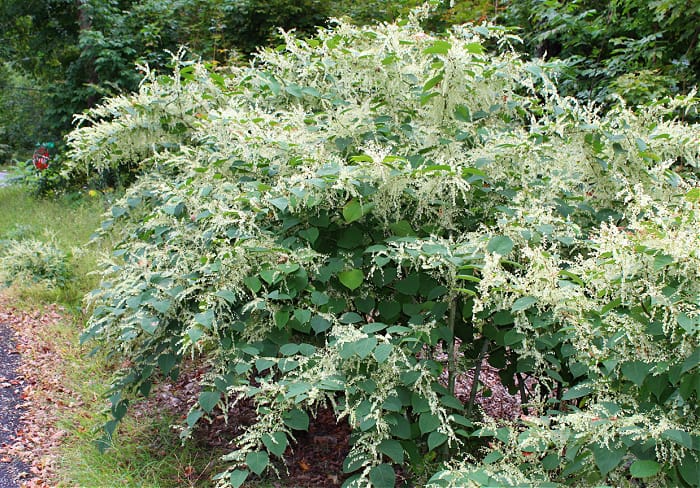Japanese Knotweed is a very invasive plant that can quickly take over your landscape. Follow these steps to get rid of Japanese Knotweed and prevent it from crowding out ornamental plants.
Japanese Knotweed has become one of the most invasive plants in the world. Believe it or not, in the late 1800’s this herbaceous perennial from East Asia was planted in estates. Later on it was used for erosion control, and by the late 1930’s it was starting to be considered an invasive plant as it started popping up in locations where it wasn’t meant to be grown.
Achieving heights up to 15 feet tall, this invasive plant that resembles bamboo quickly spreads via underground rhizomes. As it outcompetes nearby plants it can completely take over and damage ecosystems. It’s one of the last plants you want to see around your house since it can crowd out ornamental plants and takeover your landscape.
In some scenarios the canes from Japanese Knotweed can bust through asphalt and grow through stone foundations. If you notice this nuisance perennial growing on your property than follow these steps to get rid of Japanese Knotweed before it continues to spread.
How to Kill Japanese Knotweed
There’s no doubt about it, Japanese Knotweed can be tough to kill. If you want to get rid of Japanese Knotweed for good, you have to be persistent and use what I call the Cut and Herbicide combined approach. Of all the methods out there, I have seen the best success in controlling Japanese Knotweed using this strategy.
1. Cut the canes (or stems) down to the ground using loppers.
You can do this at any point from spring to early fall. If it’s spring, I like to wait until the canes emerge from the ground and start leafing out.
2. Collect all the canes and dispose of them carefully
Don’t just throw them in the woods or in an area around your yard since those canes can end up producing more plants. Instead, put the spent canes in plastic bags and dispose of them. It’s also safe to burn them if that is an option on your property.
3. Spray an herbicide that contains glyphosate, such as Roundup, over the tops of the freshly severed canes that remain in the ground.
It is very important to spray immediately after you cut the cane off. Knotweed heels very quickly and if you wait even just a couple of minutes the plant will start to block the herbicide from being soaked in.
If this means just cutting a couple of canes off at a time and spraying as you go than you’ll be better off, especially on larger plants. After spraying, the herbicide gets soaked in and carried down to the root system over the next 7 days.
Now, the interesting thing is in late summer/early fall, Japanese Knotweed reverses it’s flow of nutrients and sugars so that it flows towards the roots of the plant. Since the flow of nutrients is going towards the roots of the plant, this makes it easier for the herbicide to make its way to the root system. That is why early fall is the best time to apply herbicide to Japanese Knotweed.
In the spring, this flow is reversed since energy is going to the top of the plant where it is focusing on growing tall and increasing foliage. But, just because the flow of nutrients is away from the root system during the spring, doesn’t mean you shouldn’t spray. Spraying will still be effective, it just may require an additional treatment once it becomes late summer/early fall.
4. After spraying knotweed, don’t do anything to the knotweed for 2 weeks
This gives the plant time to fully absorb the glyphosate. After 2 weeks, you’ll probably notice some canes have started to grow again. It might even be shocking as the plant might look like its making a healthy rebound. Repeat steps 1-3 again. Cut the canes down to the ground and spray roundup immediately after.
5. This time, wait 7 days before cutting canes back
Again, this gives the plant plenty of time to absorb the glyphosate. This time around regrowth should be a little sluggish. If it’s the spring, continue to cut the canes back to the ground every week or two, or as necessary. Hold off on a third round of spraying until late summer/early fall when the flow of energy reverses and goes down to the root system. This fall application of roundup will likely be the knockout punch.
If you’re just starting this process in the fall then continue cutting canes back every week or 2 after completing the steps above. Eventually the plant will die back for the season. There’s a good chance most of the plant won’t survive the winter. If you get some canes popping up in the spring then just continue with the steps above. Eventually, you will win the war!
Removing Root System of Japanese Knotweed
If you’re looking for a more immediate approach for getting rid of Japanese Knotweed, then removing the entire plant, with its root system will give you the quickest results. This is a great approach for someone that doesn’t have the patience or time required to poison the entire plant, including the root system. But, although this method provides rapid results, it does have its problems.
One of the main problems is that removing the root system of Japanese Knotweed is not easy. It’s very difficult to do by hand and usually requires a mini excavator or backhoe to dig up the elaborate root system.
Another challenge is finding a place to dispose of the root system. Once excavated, you will be left with a large pile of very contaminated soil. You don’t want this anywhere near your landscape and hauling away can be difficult and unethical since it will contaminate the site where it ends up. Your best bet would be to dig a deep whole, line it with a poly tarp, and bury the contaminated soil.
One last problem is that it’s near impossible to get every last root. If there are any small roots left behind it’s likely they will survive. You’ll need to be constantly following up and removing plants as they continue to send up new canes.
Check Out These Posts Next
The Conifer Seed Bug: Identify, Prevent, and Remove
Fall Armyworms- Identify and Treatment
White Grubs: Prevention and Treatment
Japanese Beetles: Control and Prevention
Join my free email list!
Plus, follow me on Facebook, Instagram, and Pinterest.



Leave a Reply